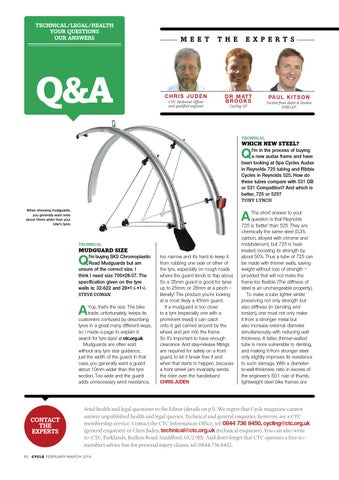Technical/Legal/Health Your questions Our answers
Q&A
M E E T
Chris Juden CTC Technical Officer and qualified engineer
T H E
E X P E R T S
d r m at t brooks Cycling GP
pa u l k i t s o n Partner from Slater & Gordon (UK) LLP
Technical
WHICH NEW STEEL?
Q
I’m in the process of buying a new audax frame and have been looking at Spa Cycles Audax in Reynolds 725 tubing and Ribble Cycles in Reynolds 525. How do these tubes compare with 531 DB or 531 Competition? And which is better, 725 or 525? Tony Lynch
A
When choosing mudguards, you generally want ones about 10mm wider than your bike’s tyres
Technical
MUDGUARD SIZE
Q
I’m buying SKS Chromoplastic Road Mudguards but am unsure of the correct size. I think I need size 700fi28-37. The specification given on the tyre walls is: 32-622 and 28fi11/4 fi13/4 Steve Cowan
A
Yup, that’s the size. The bike trade, unfortunately, keeps its customers confused by describing tyres in a great many different ways, so I made a page to explain it: search for ‘tyre sizes’ at ctc.org.uk. Mudguards are often sold without any tyre size guidance, just the width of the guard. In that case, you generally want a guard about 10mm wider than the tyre section. Too wide and the guard adds unnecessary wind resistance,
CONTACT THE EXPERTS
too narrow and it’s hard to keep it from rubbing one side or other of the tyre, especially on rough roads where the guard tends to flap about. So a 35mm guard is good for tyres up to 25mm, or 28mm at a pinch – literally! The product you’re looking at is most likely a 45mm guard. If a mudguard is too close to a tyre (especially one with a prominent tread) it can catch onto it, get carried around by the wheel, and jam into the frame. So it’s important to have enough clearance. And stay-release fittings are required for safety on a front guard, to let it break free if and when that starts to happen, because a front wheel jam invariably sends the rider over the handlebars! Chris Juden
The short answer to your question is that Reynolds 725 is ‘better’ than 525. They are chemically the same steel (0.3% carbon, alloyed with chrome and molybdenum), but 725 is heattreated, boosting its strength by about 50%. Thus a tube of 725 can be made with thinner walls, saving weight without loss of strength – provided that will not make the frame too flexible. (The stiffness of steel is an unchangeable property.) To make a tube lighter whilst preserving not only strength but also stiffness (in bending and torsion), one must not only make it from a stronger metal but also increase external diameter simultaneously with reducing wall thickness. A fatter, thinner-walled tube is more vulnerable to denting, and making it from stronger steel only slightly improves its resistance to such damage. With a diameterto-wall-thickness ratio in excess of the engineer’s 50:1 rule of thumb, lightweight steel bike frames are
Send health and legal questions to the Editor (details on p3). We regret that Cycle magazine cannot answer unpublished health and legal queries. Technical and general enquiries, however, are a CTC membership service. Contact the CTC Information Office, tel: 0844 736 8450, cycling@ctc.org.uk (general enquiries) or Chris Juden, technical@ctc.org.uk (technical enquiries). You can also write to: CTC, Parklands, Railton Road, Guildford, GU2 9JX. And don’t forget that CTC operates a free-tomembers advice line for personal injury claims, tel: 0844 736 8452.
6 0 cyc le Fe br uary /m a r c h 2 014
